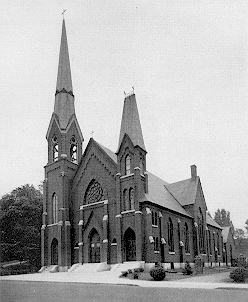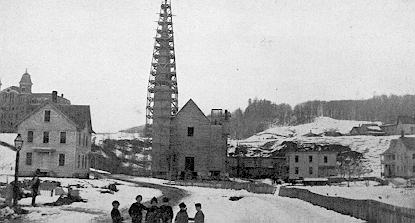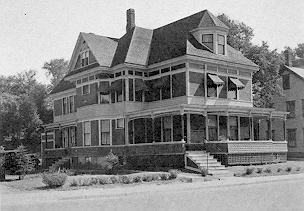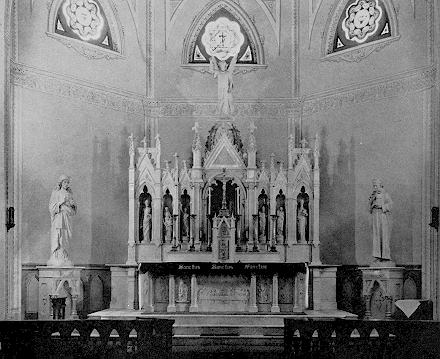
Saint Monica's Church - 1937
Saint Monica's Parish
Barre, Vermont

Saint Monica's Church - 1937
THE EARLY DAYS
When founders of Saint Monica’s parish came to Barre in the post-civil war period, there were no trains, telephones or electricity. The population of Barre, town and village together, was only 2700. Farming was the important industry, although there was also a small woolen mill and a tool shop. Conveniences of life were few, and these earlv settlers were, for the most part, endowed with very little of the world's goods. But they possessed something far more precious — a firm faith, courage and a spirit of self-sacrifice. And it was these qualities which prompted them to persevere in the practice of their Catholic Faith, even though it entailed much hardship and great inconvenience. Montpelier, an older settlement than Barre, already had had a church for some years. And for Sunday after Sunday during those early years, the faithful few in Barre would walk over the hills, or in the case of the more prosperous, drive their horse and carriage to Montpelier for Mass.
By 1881, however, the number of Catholic families in Barre had so increased that Father J. M. Duglue, pastor of the church in Montpelier, arranged to come here for divine service on one Sunday a month. The Holy Sacrifice of the Mass was first celebrated in Barre on November 13, 1881, in the old town hall over what was later known as the Houghton and Robins store. The seventeen people who attended this first Mass included Mr. and Mrs. John Conway and family, Mr. and Mrs. Thomas Williams and family, Mr. and Mrs. Bernard Laughlin and son, Mr. and Mrs. John Whelan (Later she was Mrs. Annie Barclay), Michael Herlihy, Patrick Keogh and Mr. and Mrs. Lacourse.
Transporting the priest to Barre, converting the hall into a chapel, carrying wood and starting the fires, all had to he done when the people were privileged to hear Mass. Confessions were heard and the Sacrament of Baptism administered for many years at John Conway's house on South Main Street. Father Dugle and his successor resided with the Conways while in Barre.
Jackman’s Hall, over Averill’s hardware store, was secured for religious services in 1882, and Mass was said there until 1886. Here also an September 9, 1883 the Sacrament of Confirmation was administered in Barre for the first time by Bishop DeGoesbriand, first bishop of the diocese. An interesting item relative to the history of this period is the record of a census taken by Father Duglue in the spring 1882. This census shows a total of 31 families in the Barre Mission of whom two-thirds were Irish and one-third French.
In the year 1885, the Reverend W. J. O'Sullivan succeeded Father Duglue as pastor of St. Augustine's Church in Montpelier. By this time operation of the Barre granite quarries had commenced in earnest and many workers had come here from other parts of Vermont and New York State. The size of the rapidly growing congregation at the Barre Mission prompted Father O'Sullivan to seek a more commodious hall and in 1886 he leased the old Spaulding Academy for religious purposes. Here the congregation assumed organized shape and permanent form, and gave promise of fruitful possibilities in the future. The first Catholic marriage in Barre was solemnized in this hall — that of Thomas Carroll and Mary Marrion.

THE NEW CHURCH RISES - 1887
It soon became evident to Father O'Sullivan, however, that the old Academy hall could not long accommodate the increasing numbers of the Barre Mission. The advisability of building a church was suggested and met with universal approval. A committee including Thomas Williams and John Conway was appointed to select a desirable location. Three building lots were purchased at the intersection of the road leading to Goddard Seiminary. Ground was broken without delay, the men of the parish digging the cellar to save expense, and on October 2, 1887, the cornerstone of the new church was laid with imposing ceremonies in the presence of the largest concourse of people ever before assembled in Barre. The Rev. P. J. Barrett of Burlington was the guest speaker on this occasion and Bishop DeGoesbriand blessed the cornerstone.
Sixteen months later the church was completed and dedicated to St. Monica, mother of Saint Augustine, patron of the Montpelier church. The cost of the new church was about $25,000, including the building lots. The greater part of this sum was raised by fairs, collections, and subscriptions. There were less than 100 families in the parish and it is needless to say that each and every one of them, made up as they were of laboring people, worked hard and contributed generously.
The completed church as it was seen in 1937, was a fitting memorial to the faith and devotion of these pioneer Catholics who contributed so generously to its erection. It is an imposing brick structure, richly trimmed with Barre granite. It is built in the Gothic type of architecture and its interior is much admired for the gracefulness of its structural proportions and the simple beauty of its decorations. Unique among its decorations is the magnificent set of stations of the cross which were imported from Munich, Germany.

Saint Monica's Rectory - 1937
THE RECTORY
Soon after 1890 the interests of the growing congregation, in the rapidly expanding village of Barre, demanded the services of a resident priest. In January, 1892, therefore, the Bishop appointed the Rev. Joseph Brelivet as first resident pastor of St. Monica's. Father Brelivet remained only two years, however, and on November 9, 1894, he was succeeded by Reverend P. M. McKenna.
During the pastorate of Father Brelivet and for two years after the arrival of Father McKenna, the parish owned no rectory. A tenement in John Gordon's house, on Maple Avenue, was used to house the priest, and the neighbors in the vicinity saw to it that the priest's material needs were taken care of. But in 1895 a spacious rectory was erected on the south side of the church and Father McKenna was. able to take up permanent quarters.

St. Monica's Altar - 1937
THE NEW ALTAR - 1905
With the erection of a rectory and the purchase of the convent accomplished, Fr. McKenna was able to turn his attention toward improving the church. Outstanding among the improvements of this period were the addition of a large vestry, which also served as chapel, to the rear of the church, the purchase of a pipe organ and the erection of a new marble altar. The latter, since it is perhaps the finest piece of work of its kind in the diocese, is deserving of special mention. For several years only a modest wooden altar served the needs of the parish in the celebration of the Holy Sacrifice. But, in 1905, the artistic appreciation of the congregation, developed through their work in the granite industry, was eventually satisfied when a beautiful Gothic altar of marble was imported from Carrara, Italy, through the efforts of Mr. Joseph Sanguinetti. Everyone who visits the church is impressed bv the rare beauty of the hand carving on the altar, by the delicate sculpturing of the statues and scroll work which adorn it, and by the exquisite carving of the bas-relief panel depicting the Last Supper. Although the original cost of the altar was onlv $2,000 — it was estimated that it would cost more than $20,000 to reproduce it at the time this article was written in 1937.

Saint Monica's School - 1937
ST. MONICA'S SCHOOL
By the time of Father Mc Kenna’s death in March 1926, Saint Monica’s parish had grown, through his zealous work, to number more than 8oo families. Shortly before his death, Father McKenna purchased from various owners a large tract of land in the rear of the church property, known as Addison Place. This land was cleared of some rather unsightly tenement houses and later made into a playground for the children
Father McKenna was succeeded by pastor Rev. Eugene F. Cray, in March, 1926. Father Cray was no stranger to most of the parishioners as he had been stationed at St. Monica's as a curate from 1903 to 1909. Almost the first act of the new pastor was the purchase of the Summer Street graded school from the city of Barre. The auturrm of 1927 marked the entrance of the first class into St. Monica's parochial school. Two years later the building was enlarged to more than twice its former size by the addition of a modern brick structure to the front of the original building. In 1934 the first class was graduated from the school.
EARLY FAMILIES
A contribution list for the year 1895 provided the following names of the families which then made up the parish.
| ARMSTRONG BARCLAY BISSONETTE BOYLE BRESSAW BROWN BURKE BUTLER CALLAHAN CANTON CARROLL CASEY CAYUE CHARBONNEAU CLEARY CONLON CONWAY COYLE DENNING DEVER DEZIEL DORAN DOUGLASS DRUMGOULD |
DUFFY DUPREY FLANAGAN FRENIER GALLAGHER GARVEY GIBBONS GINGRAS GODIN GONYO GRADY GRANGER GREGORY GRENIER GRIFFIN HAMEL HANNON HARRINGTON HENES HENNESSY HOYT HYLAND KEEFE KELLY |
KENNEDY KENEFICK KINGSTON KREGAN LAVERY LAUGHLIN LORANGER McCLARY McCAFFERY McGOWAN McHUGO McLAUGHLI McMAHON McQUAID McSWEENEY MACHIER MAHON MALONEY MARR MARRION MENCHEN MERTZ MILES MOORE |
MURPHY NELSON NICHOLS NOONAN NORMANDEAU O'BRIEN O'HARA O'ROURKE O'SHEA QUINLAN RILEY RODERER ROONEY RYAN RYLE SAWYER SMITH STARR SULLIVAN TIERNEY WELLS WILLIAMS WOODS |